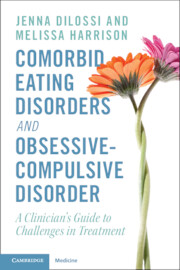 Comorbid Eating Disorders and Obsessive-Compulsive Disorder
Comorbid Eating Disorders and Obsessive-Compulsive Disorder from Part III - Evidence-Informed Considerations for Assessment and Treatment
Published online by Cambridge University Press: 14 December 2023
Body image concerns can be a significant barrier to treatment for individuals with eating disorders (EDs) and impact upon relapse risk. Body image difficulties can be challenging for clinicians and tend to be a lasting source of pain for ED patients. For ED with OCD, behaviors typically seen in ED presentations may be exacerbated. Body dissatisfaction and dysmorphia are common in EDs and often linked to sociocultural factors such as societal pressure and media representation. The media is heavily implicated in the prevalence of body dissatisfaction due to the amounts of misleading health advice and trends on social media which make people more anxious, aware, or insecure about their bodies. Media and political environments often underrepresent and stereotype women, people of color, and LGBTQ+ individuals, which can perpetuate negative stereotypes and biases that further marginalize people due to appearance. Given the widespread nature of body dissatisfaction and cultural messages that link a person’s worth to appearance, it is not surprising that people with OCD may become obsessed with these issues. This can make treatment more challenging, particularly when OCD and EDs are comorbid.
To save this book to your Kindle, first ensure [email protected] is added to your Approved Personal Document E-mail List under your Personal Document Settings on the Manage Your Content and Devices page of your Amazon account. Then enter the ‘name’ part of your Kindle email address below. Find out more about saving to your Kindle.
Note you can select to save to either the @free.kindle.com or @kindle.com variations. ‘@free.kindle.com’ emails are free but can only be saved to your device when it is connected to wi-fi. ‘@kindle.com’ emails can be delivered even when you are not connected to wi-fi, but note that service fees apply.
Find out more about the Kindle Personal Document Service.
To save content items to your account, please confirm that you agree to abide by our usage policies. If this is the first time you use this feature, you will be asked to authorise Cambridge Core to connect with your account. Find out more about saving content to Dropbox.
To save content items to your account, please confirm that you agree to abide by our usage policies. If this is the first time you use this feature, you will be asked to authorise Cambridge Core to connect with your account. Find out more about saving content to Google Drive.